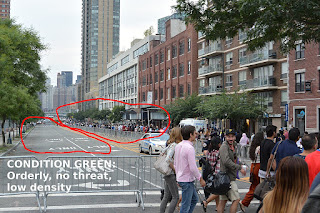
I'm a member of New York City's CERT (Community Emergency Response Team), and we're volunteers that provide support to other emergency responders: if we can relieve a policeman or fireman to do more important jobs, that's a great help to them. For example, crowd control (for certain kinds of events) is something that we are trained and can help with, along with some traffic control and management.
In the spirit of best informing me and preparing for such events, I found several resources that a consolidated to a single-sheet two-pager, including Coopers Colors of Situational Awareness, and a related Wikipedia article on Coopers Colors.
The idea of the two-pager was to combined (1) safety knowledge (EIAI article), (2) measurement/assessment techniques (estimating people per square meter), and (3) a quick assessment label with a color code scheme (adapted from Coopers Colors).,
I'd be interested in hearing others' experiences in this area. The text and diagrams below. The pictures and notation are taken from the NYC Macy's July 4 Fireworks event in 2015, and I've served at the 2016 and this year's events.
Any thoughts?
__________________________________________________________________
Crowd Conditions Situational Awareness
(adapted from Coopers
Colors of Situational Awareness,
and Crowd Risk Analysis and Crowd Safety)
and Crowd Risk Analysis and Crowd Safety)
BE AWARE OF CROWD
DENSITY, THREATS, AND POTENTIAL THREATS.
HAVE AN EXIT PLAN.
Standing Crowds are different from Moving Crowds.
Crowds greater than 5pm2 standing or 3pm2
in motion are dangerous. A meter is
approximately 1 yard, so 5 persons per square yard (standing) or 3 persons per
square yard (moving) is the threshold density.
CONDITION GREEN:
You are relaxed and the situation around you is normal. The situation is orderly, and there is
nothing needing your concern.
This picture has an orderly crowd lined up, and half the
street is open available for emergency access.
CONDITION YELLOW:
You remain relaxed, but are aware of who and what is around you. Mentally, you are taking inventory of the
people, objects, and circumstances around you.
This is a picture of an NYPD checkpoint. Crowd density is low because you've organized
the participants in a line for NYPD.
However, be on alert for people cutting the line, people
asking questions, line delays (because people aren't yet ready to have their
bags checked), and other possible disturbances.
CONDITION ORANGE:
You have identified something of interest that may or may not prove to be a
threat. Until you determine the true nature of whatever has piqued your
interest, your “radar” is narrowed to concentrate on the possible threat and
will remain so focused until you are satisfied no threat exists.
After the event is over, the outflow can start to increase
from Yellow, to Orange, to Red, to Black.
Here is the Orange Condition immediately in front, but the crowd behind
will be Red Condition and arriving in ~60 seconds.
CONDITION RED:
If the focus of your attention in Condition Orange does something you find
threatening, you will shift to Condition Red.
On the left side and immediately in front is a crowd density
of 3pm2 (3p/sq-m), which is the limit of safe moving crowds.
However, the further rush of the outflow pushes the density
past the limit on the right side and behind.
CONDITION BLACK:
Unsafe, exit unsafe condition immediately.
The crowd is now funneling through sidewalks and streets
with parked cars, which increase the crowd density. Because of the continual outflow of people,
they will push, it becomes denser, and the outflow backs up into very high
density. This density of this crowd on
the right sidewalk mid-block is >3pm2 (3p/sq-m), which is unsafe.
ALWAYS BE AWARE OF
YOUR PERSONAL SAFETY. USE THE BUDDY
SYSTEM.






What would the Hamburg crowds of rioters be classified as - Condition Leveled? The rioters' anti-globalist, anti-capitalist, anti-fascist etc complaints are at https://g20tohell.blackblogs.org/g20-welcome-to-hell/.
ReplyDeleteHelen, I'm sure one could guestimate from photos the crowd density (i.e., numerically). I went to your link, but I didn't see any photos of crowds that you were referencing. Did I miss something?
ReplyDeleteWell, you know how my mind works. It's nice to have categories and fit things neatly therein. But what if something can't fit into Category A, B, or C? Then what? Your blending the photos with the categories was nice - maybe it will be adapted by the CERT as a visual representation of the categories/levels of crowd density. But what about an out & out riot? The question of course was meant rhetorically or ironically. The link goes to the anarchists' "organization" (is that even possible) which outlines some of their complaints (what they are protesting) and includes links to associated "groups." There were two nights of riots in Hamburg mostly to protest capitalism (I guess) - so these crowds of anarchists would be off the scale, impossible to categorize according to the schema you discussed. Of course I know that, & I meant my comment (of course) to be understood ironically/humorously. Sorta of like saying this amp goes to 11. Actually I was trying to think up an image or color that would accommodate/describe/represent crowds rioting - so it could be included in the schema. But I couldn't think of one. Dayglo violet? Or maybe the color of the light they used to shine on dollar bills to ascertain they were real? Or the color of the light used to zap mosquitoes in those mosquito zapping devices (if they are still used)?
Delete